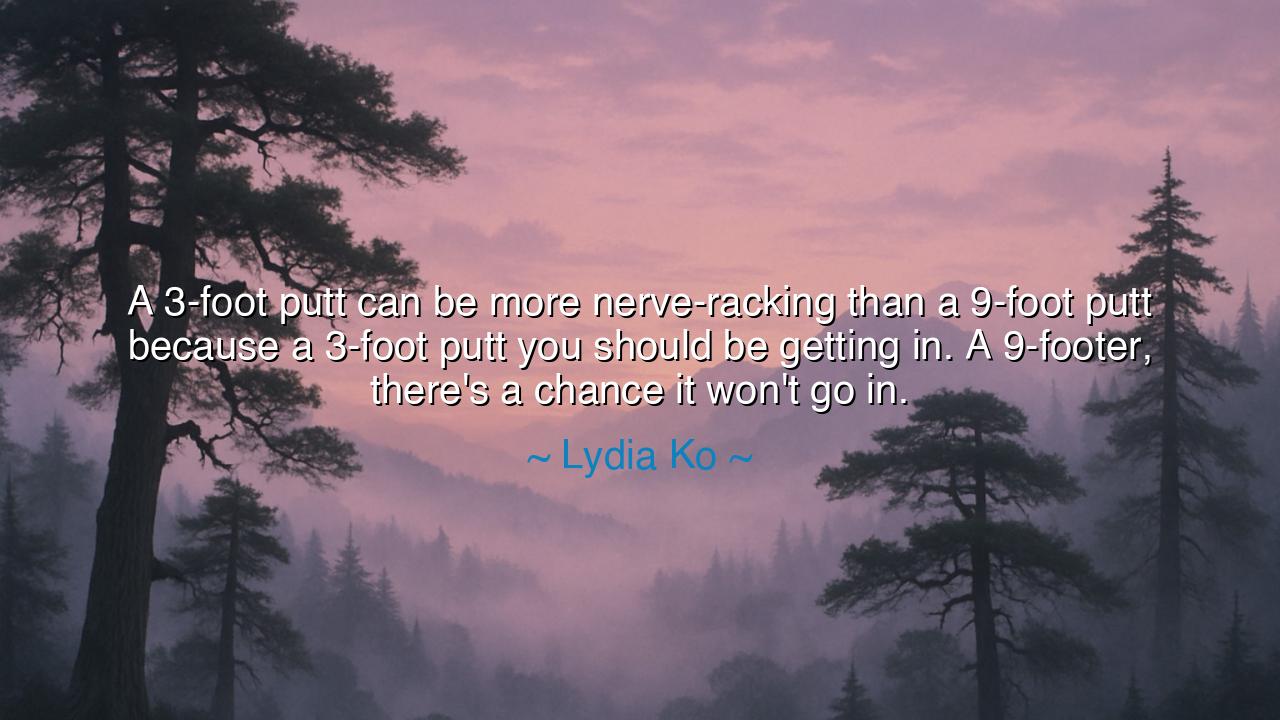
A 3-foot putt can be more nerve-racking than a 9-foot putt
A 3-foot putt can be more nerve-racking than a 9-foot putt because a 3-foot putt you should be getting in. A 9-footer, there's a chance it won't go in.






In the great arena of life, where every step and every action carries the weight of both possibility and consequence, there exists a profound truth: the greatest challenges are often not those that seem the most difficult, but those that appear deceptively simple. Lydia Ko, in her observation about the mental challenges of golf, captures this truth with remarkable clarity. “A 3-foot putt can be more nerve-racking than a 9-foot putt because a 3-foot putt you should be getting in. A 9-footer, there's a chance it won't go in.” These words, spoken about a game of precision and patience, hold wisdom that reaches far beyond the greens and fairways—into the very core of human experience.
At first glance, it might seem that the 3-foot putt—so short, so seemingly easy—would be the one most assured of success. But Ko reveals a deeper truth: it is precisely because we expect to succeed at it that the pressure mounts. The short distance should give confidence, yet it creates the unbearable weight of expectation. When the outcome is all but certain, any deviation feels like a failure. The 9-foot putt, on the other hand, carries with it the grace of uncertainty—it is far enough to justify a miss, so the pressure is somewhat alleviated. In this, Ko teaches us that the greatest source of tension often arises not from the grand challenges, but from those moments where we feel we should succeed, and the fear of falling short seems unbearable.
Consider the ancient warriors who stood on the battlefield, facing great odds and seemingly insurmountable enemies. They knew that in the chaos of war, victory was never assured, but the fear of failure could paralyze them even before the battle had begun. It is said that the mighty Spartans, while revered for their courage, also understood the nature of the mind in battle. They trained not just their bodies, but their wills, knowing that the greatest enemy was often the fear of failure that crept in when the stakes felt too high. In the same way, the 3-foot putt in golf becomes a metaphor for those moments in life when we feel the weight of expectation—the smallest actions that carry the heaviest burden, and the greatest fear of not living up to what we believe we should achieve.
Ko’s words echo the struggles of great figures from history who faced not only external challenges, but internal conflicts of self-doubt and expectation. Take Leonidas, the king of Sparta, who, before the Battle of Thermopylae, stood against the mighty Persian Empire with only a small band of warriors. They knew their chances were slim, but the pressure of honor and duty gave them strength. They did not fear the impossible task ahead, but rather, the idea of failing in front of their people, for their mission was not just about winning—it was about upholding the ideals of courage and sacrifice. The Spartan warriors, like Lydia Ko, understood that it was not the greatness of the challenge but the expectations that made the true test.
In our own lives, we are faced with countless moments that mirror the 3-foot putt—seemingly simple tasks that carry the heavy burden of expectation. These are the moments when we feel the eyes of the world upon us, when we believe that success should be assured, and failure is unthinkable. The pressure builds in these quiet moments, when there is no external force to blame, and we are left alone with our self-doubt. The true test, however, is not in overcoming the external obstacles, but in conquering the internal fear that arises when we feel we should do better, or when the outcome is too important to fail.
Just as a 9-foot putt carries the understanding that the odds are not in our favor, the greater challenges in life allow us the grace of uncertainty. In these moments, we accept the possibility of failure, and this acceptance relieves the mental strain that often paralyzes us in smaller, more routine tasks. The lesson, then, is not about avoiding difficulty but about redefining our relationship with expectation. Whether in our careers, our personal goals, or our relationships, we must understand that the weight of expectation can be our greatest enemy. To accept uncertainty, to embrace the possibility of failure, is to find freedom and strength in those moments.
Lydia Ko’s words offer us a valuable lesson: success is not only about the size of the challenge but about our mental preparation to face it. Small challenges can be more terrifying than the larger ones because they bring with them the burden of certainty. Accepting uncertainty, allowing ourselves the freedom to miss and to fail without shame, is key to unlocking our full potential. Like a golfer taking a breath before a crucial putt, we must learn to step back, acknowledge the weight of expectation, and choose to act without fear. In doing so, we find not only success but peace. Let us take Ko's wisdom into our own lives and face each moment, whether large or small, with courage and clarity, knowing that true victory lies not in perfection, but in the freedom to try again.






AAdministratorAdministrator
Welcome, honored guests. Please leave a comment, we will respond soon